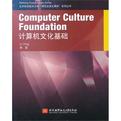Computer Culture Foundation计算机文化基础
2012-9
北京航空航天大学出版社
李莹
204
297000
This book includes 4 chapte. They are
basic knowledge of computer, introduction of operating system,
Microsoft Office 2003 and computer networks. This book focuses on
basic computer concepts, basic principles, basic knowledge and
basic application methods of computer. According to the book,
students can have a clear undetanding of computer. This book can
serve as computer hased English teaching materials for univeity
undergraduate and postgraduate students and international students
of all majo. It is also applied to other reade with a certain
standard tutorial of English for self-study and reference.
Chapter I Basic Knowledge of Computer
1.1 The Development of Computer
1.1.1 The Development of the Electronic Computer
1.1.2 Computer Generatio
1.1.3 The Features and Applicatio of Compute
1.1.4 Computer Types
1.1.5 New Technology in Compute
1.2 Data Representation in Compute
1.2.I Using Binary in Compute
1.2.2 Number Systems
1.2.3 Binary, Octal and Hexadecimal
1.2, 4 Positional Notation
1.2.5 Convert from Other Bases to Base 10
1.2.6 Convert Base 10 to Other Bases
1.2.7 Convert Octal to Hexadeeimal
1.2.8 Information Units
1.2.9 Number
1.2.10 ASCII
1.3 Computer Hardware Components
1.3.1 Arithmetic/Logic Unit
1.3.2 Control Unit
1.3.3 Memory
1.3.4 Input/Output Unit
1.3.5 Architecture of Computer
1.4 The Composition of Microcomputer
1.4.1 Host
1.4.2 Input Device
1.4.3 Output Device
1.5 Software System
1.5.1 Operating System
1.5.2 Process and Thread
1.6 Questio
Chapter 2 Introduction of Operating System
2.1 Operating System
2.1.1 Introduction
2.1.2 File System
2.2 Graphical User Inter{ace
2.3 File and Folder Management
2.3.1 Change View o{ Files and Folde
2.3.2 Delete Files or Folde
2.3.3 Find Files
2.3.4 Create Shortcut
2.4 Basic Operation
2.4.1 Itall Computer Hardware
2.4.2 Set up BIOS
2.5 Configuration
2.6 Applicatio
2.7 Registry
2.7.1 Viewing the Registry with REGEDIT
2.7.2 Overview of Registry
2.7.3 Backing up Registry Manually
2.7.4 Restoring the Registry
2.8 Questio
Chapter 3 Microsoft Office 2003
3.1 Word Processing So{tware--Word
3.1.1 The Basic Edition of Documents
3.1.2 Typeset the Document
3.1.3 Draw Table
3.1.4 Combine Picture and Text
3.1.5 Typeset
3.1.6 Review
3.1.7 Questio
3.2 Excel
3.2.1 Introduction
3.2.2 Excel Interface and Components
3.2.3 Input and Fill Excel
3.2.4 Formula and Function
3.2.5 Format a Table
3.2.6 Charts in Excel
3.2.7 Manage Data
3.2.8 Questio
3.3 PowerPoint
3.3.1 Basic Operation of PPT
3.3.2 Background, Color Scheme, Master and Template
3.3.3 Beautify the PPT
3.3.4 Automation Effects and Playing the PPT
3.3.5 Questio
Chapter 4 Computer Networks
4.1 Basic Knowledge of Computer Networks
4.1.1 Overview of Computer Networks
4.1.2 Protocol
4.2 Build Computer Network
4.2.1 Network Devices
4.2.2 Create LAN
4.2.3 IP Address and DNS
4.3 Introduction to Internet
4.4 Questio
References
版权页: 插图: DVD is a newer technology that can store up to 10 GB. DVD, which stands for Digital Versatile Disk, can store multi-media presentations that combine audio and video. As you probably know, movies are now available on DVDs. The acronym CD-WORM stands for Write Once, Read Many. This technology allows a CD to be recorded after it is manufactured. This format is used typically for archiving data, where the data is not to he changed after being recorded. Then, finally, the acronyms RW or RAM mean that the disk can be both read from and written to. 3) Flash memory Flash memory (sometimes called "flash RAM") is a type of constantly-powered nonvolatile memory that can be erased and reprogrammed in units of memory called blocks. It is a variation of Electrically Erasable Programmable Read-Only Memory (EEPROM) which, unlike flash memory, is erased and rewritten at the byte level, which is slower than flash memory updating. Flash memory gets its name because the microchip is organized so that a section of memory cells are erased in a single action or "flash". The erasure is caused by Fowler-Nordheim tunneling in which electrons pierce through a thin dielectric material to remove an electronic charge from a floating gate associated with each memory cell. Intel offers a form of flash memory that holds two bits(rather than one)in each memory cell, thus doubling the capacity of memory without a corresponding increase in price. Flash memory is used in digital cellular phones, digital cameras, LAN switches, PC cards for notebook computers, digital set-up boxes, embedded controllers, and other devices. 1.4.2 Input Device Common input devices are the keyboard, the mouse, the joystick, the trackball and the scanner. Disk drives are input, memory and output devices. 1. Keyboard It is a text base input device that allows the user to input alphabets, numbers and other characters. It consists of a set of keys mounted on a board.

Computer Culture Foundation计算机文化基础 PDF格式下载